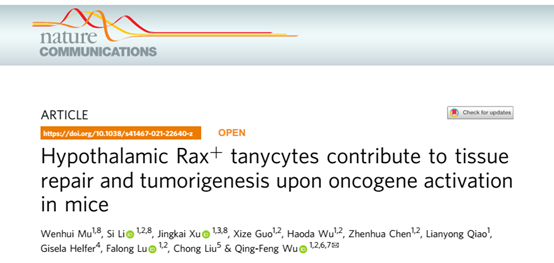12 20, 2021
Hypothalamic tanycytes contribute to tissue repair and tumorigenesis


Hypothalamic tanycytes in median eminence (ME) are emerging as a crucial cell population that regulates endocrine output, energy balance and the diffusion of blood-born molecules. Tanycytes have recently been considered as potential somatic stem cells in the adult mammalian brain. While somatic stem cells in general are characterized by their self-renewal, regenerative and tumorigenic potential, it remains largely unknown how ME tanycytes maintain themselves and to what extent the disturbance of such homeostasis contributes to diseases such as cancer.
Recently, a study published in Nature Communications, led by Dr. Qing-Feng Wu from Institute of Genetics and Developmental Biology, Chinese Academy of Sciences (CAS), revealed the regenerative and tumorigenic potential of adult Rax+ tanycytes in the context of ME stem cell niche.
In this study, the researchers found that Rax+ tanycytes in ME of mice are largely quiescent but quickly enter the cell cycle upon neural injury for self-renewal and regeneration. Mechanistically, genetic ablation of Igf1r signaling in tanycytes impairs tissue repair under injury conditions. Further investigation showed that Braf oncogenic activation is sufficient to transform Rax+ tanycytes into actively dividing tumor cells that eventually develop into a papillary craniopharyngioma-like tumor. These findings uncover the regenerative and tumorigenic potential of tanycytes.
Taken together, this study identified Rax+ tanycytes as slow-cycling cells wherein quiescence may preserve their inherent longevity and further revealed the previously underappreciated role of adult tanycytes in tissue repair and tumorigenesis and establish a craniopharyngioma mouse model, which may unlock an avenue for regenerative medicine and cancer therapy in the central nervous system.

A graphical model showing the regenerative and tumorigenic potential of Rax+ tanycytes.